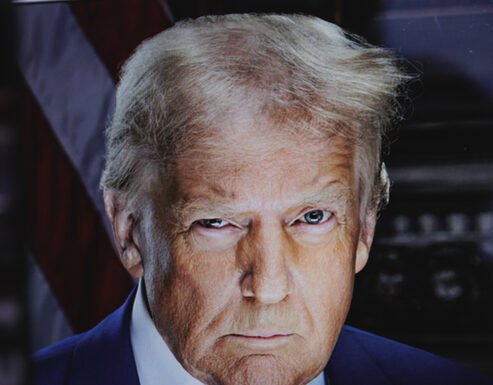President Donald Trump released another AI-generated video on the night of September 30, 2025, targeting House Minority Leader Hakeem Jeffries from New York. The video surfaced just before the federal government shutdown at midnight, intensifying the already strained funding negotiations with congressional Democrats.
Shared on Trump’s Truth Social platform, the video featured footage of Jeffries criticizing the president’s previous AI post as “disgusting” during an MSNBC interview. The video was modified to include an AI-generated mariachi band with Trump’s face on each member, and digitally added a sombrero and mustache to Jeffries, who is Black, as mariachi music played.
This video followed a prior AI-manipulated post on Monday, which faced widespread criticism. It depicted Jeffries with a sombrero and mustache, alongside Senate Minority Leader Chuck Schumer of New York speaking in a fabricated voice. This was posted shortly after the two Democratic leaders had met with Trump at the White House.
In the Monday video, the fake Schumer voice stated, “Look, guys, there’s no way to sugarcoat it. Nobody likes Democrats anymore.” The altered audio further claimed that Democrats had lost voters due to woke policies and that even Black people didn’t want to vote for them anymore.
Jeffries responded to the initial video on social media, stating that “bigotry will get you nowhere.” Schumer noted that if Trump viewed the shutdown as a joke, it showed he lacked negotiation skills and could only throw tantrums.
House Speaker Mike Johnson of Louisiana was heard criticizing Trump’s AI video on Tuesday during a conversation with Pennsylvania Rep. Madeleine Dean. When Dean questioned Johnson about the video, he replied, “It wasn’t my style.”
Dean commented that the video was disgraceful and racist, urging Johnson to denounce it. As Johnson returned to his office, he assured Dean that he was addressing the matter and reiterated that it wasn’t his personal style.
Afterward, Dean told reporters that Johnson asked her if she truly believed the video was racist. She responded by questioning whether placing a sombrero on a Black man leading the House wasn’t racist.
Johnson later appeared to change his stance when interviewed by CNN, describing the video as a joke and asserting that the primary issue was keeping the government operational for Americans, not social media posts.
The president’s social media actions occurred amid a deadlock in government funding negotiations. Attempts by both parties to extend federal funding failed in the Senate on Tuesday evening, resulting in the government shutdown at 12:01 a.m. on Wednesday, October 1.
During the Tuesday Truth Social posts, Trump also shared photos from Monday’s Oval Office meeting with Democratic leaders. The images captured Trump pointing at Jeffries from behind the Resolute desk. The photos also showed “Trump 2028” campaign hats that Trump reportedly attempted to give to the Democratic leaders, who declined them. Jeffries turned to Vice President JD Vance for his thoughts on the gesture, to which Vance reportedly replied “No comment,” drawing laughter from the room.
The funding disagreement hinged on differing party demands. Republicans sought to pass a continuing resolution that would maintain current funding levels until mid-November. Democrats required the inclusion of an extension for expiring Affordable Care Act tax credits and a reversal of some Medicaid reductions.
Jeffries highlighted the healthcare stakes at a press conference, stating that “more than 20 million Americans” were at risk of facing significantly higher premiums, co-pays, and deductibles due to the Republican refusal to extend the Affordable Care Act tax credits benefiting working-class Americans.
The enhanced premium tax credit helps 22 million Americans reduce their health insurance costs when purchasing plans through the Affordable Care Act marketplaces. This credit has been in place since 2021 and is scheduled to expire at the end of 2025. Following its implementation, enrollment in ACA marketplace health insurance plans nearly doubled.
Senate Majority Leader John Thune of South Dakota accused Democrats of changing their position because Trump now occupies the White House. He asserted there was nothing to negotiate, labeling it a routine funding resolution to keep the government running.
Though Republicans control majorities in both the House and Senate, most Senate legislation requires 60 votes to proceed. With 53 Republicans, Democratic support is essential for passing funding measures.
The White House meeting on Monday marked the first time congressional leaders and the president met to discuss the funding impasse after Trump canceled a planned meeting the previous week. Vice President Vance remarked after the meeting that he anticipated a shutdown. Schumer indicated significant differences between the two sides.
The Congressional Budget Office projected that around 750,000 federal employees could face furlough during the shutdown, though they would receive back pay afterward. Essential workers, including law enforcement, military personnel, and air traffic controllers, would remain on duty without pay.
Trump warned he might use the shutdown to implement actions detrimental to Democrats and irreversible by them, such as reducing the number of people involved. Vice President Vance mentioned at a White House press briefing that “We are going to have to lay some people off if the shutdown continues.”
Federal employees across various government sectors received messages on Wednesday morning blaming Congressional Democrats for the shutdown. Small Business Administration employees were given suggested language for out-of-office automatic replies, stating they were unavailable because Senate Democrats voted to block a clean federal funding bill, resulting in a government shutdown.
A PBS News/NPR/Marist poll conducted from September 22 to September 26 found Americans divided on assigning blame, with 38 percent attributing it to Republicans, 27 percent to Democrats, and 31 percent believing both parties were equally responsible. The poll surveyed 1,477 U.S. adults, with a margin of error of 3.1 percentage points.
The previous government funding gap, lasting from December 2018 to January 2019, resulted in a “permanent loss of about $3 billion,” according to the Congressional Budget Office.








